24.9 Heterocyclic Amines
As noted in Section 15.5 in connection with a discussion of aromaticity, a cyclic organic compound that contains atoms of two or more elements in its ring is a called a heterocycle. Heterocyclic amines are particularly common, and many have important biological properties. Pyridoxal phosphate, a coenzyme; sildenafil (Viagra), a well-known pharmaceutical; and heme, the oxygen carrier in blood, are a few examples.
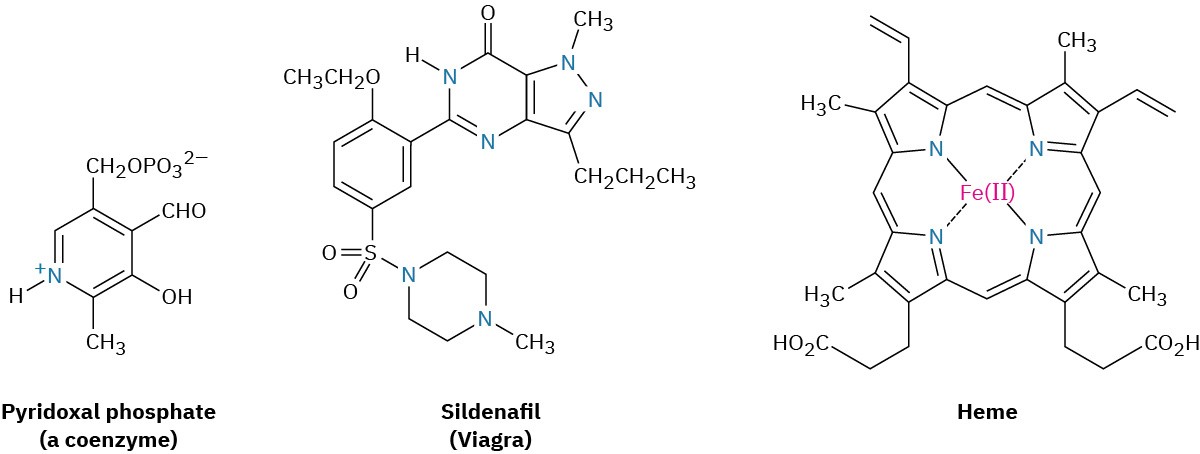
Most heterocycles have the same chemistry as their open-chain counterparts. Lactones and acyclic esters behave similarly, lactams and acyclic amides behave similarly, and cyclic and acyclic ethers behave similarly. In certain cases, however, particularly when the ring is unsaturated, heterocycles have unique and interesting properties.
Pyrrole and Imidazole
Pyrrole, the simplest five-membered unsaturated heterocyclic amine, is obtained commercially by treatment of furan with ammonia over an alumina catalyst at 400 °C. Furan, the oxygen-containing analog of pyrrole, is obtained by acid-catalyzed dehydration of the five-carbon sugars found in oat hulls and corncobs.
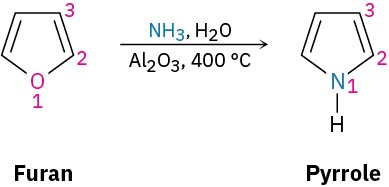
Although pyrrole appears to be both an amine and a conjugated diene, its chemical properties are not consistent with either of these structural features. Unlike most other amines, pyrrole is not basic—the pKa of the pyrrolinium ion is 0.4; unlike most other conjugated dienes, pyrrole undergoes electrophilic substitution reactions rather than additions. The reason for both of these properties, as noted in Section 15.5, is that pyrrole
has six π electrons and is aromatic. Each of the four carbons contributes one π electron, and the sp2-hybridized nitrogen contributes two more from its lone pair.
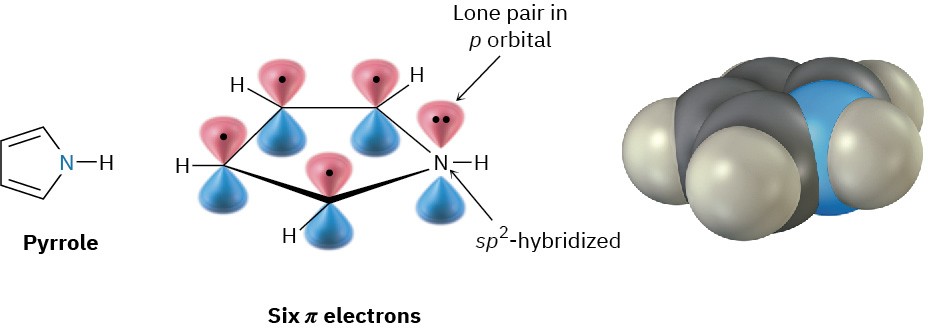
Because the nitrogen lone pair is a part of the aromatic sextet, protonation on nitrogen would destroy the aromaticity of the ring. The nitrogen atom in pyrrole is therefore less electron-rich, less basic, and less nucleophilic than the nitrogen in an aliphatic amine. By the same token, the carbon atoms of pyrrole are more electron-rich and more nucleophilic than typical double-bond carbons. The pyrrole ring is therefore reactive toward electrophiles in the same way as enamines (Section 23.11). Electrostatic potential maps show how the pyrrole nitrogen is electron-poor (less red) compared with the nitrogen in its saturated counterpart pyrrolidine, while the pyrrole carbon atoms are electron-rich (more red) compared with the carbons in 1,3-cyclopentadiene.
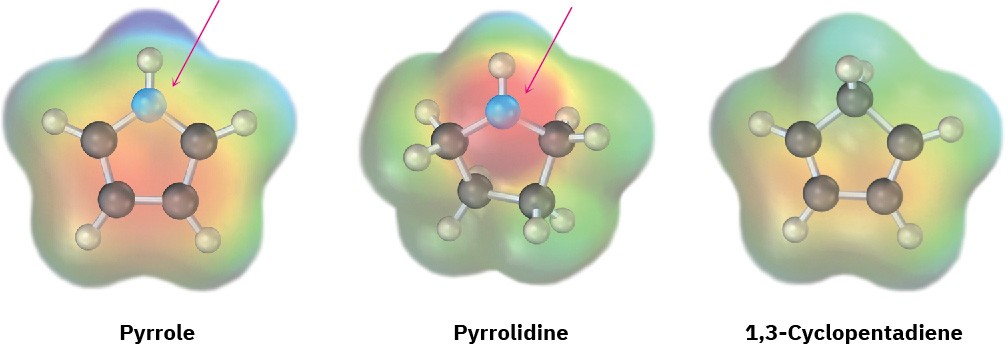
The chemistry of pyrrole is similar to that of activated benzene rings. In general, however, the heterocycles are more reactive toward electrophiles than benzene rings, and low temperatures are often necessary to control the reactions. Halogenation, nitration, sulfonation, and Friedel–Crafts acylation can all be accomplished. For example:
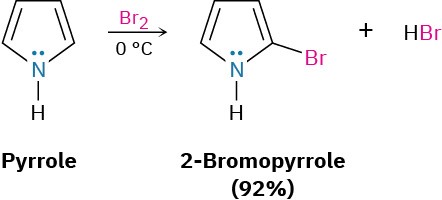
Electrophilic substitutions normally occur at C2, the position next to the nitrogen, because reaction at this position leads to a more stable intermediate cation having three resonance
forms, whereas reaction at C3 gives a less stable cation with only two resonance forms (Figure 24.8).
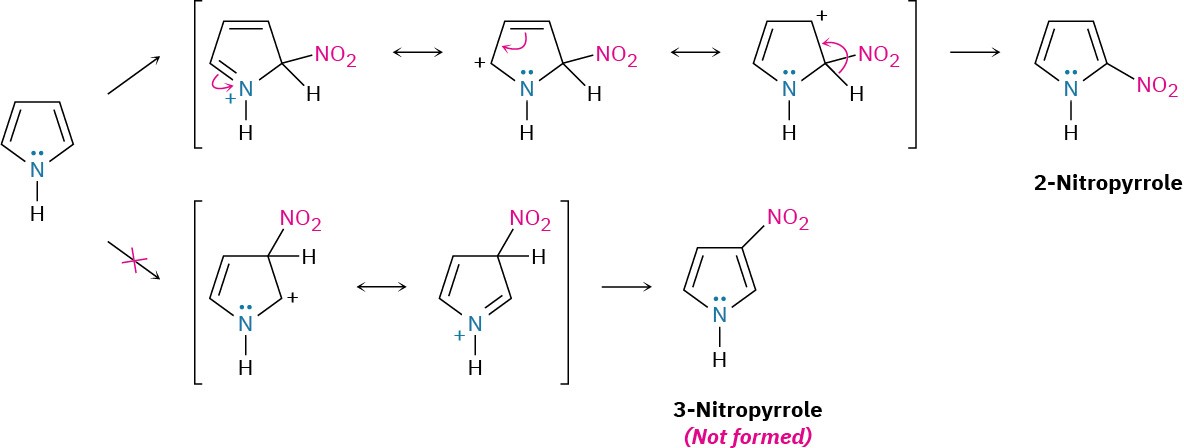
Figure 24.8 Electrophilic nitration of pyrrole. The intermediate produced by reaction at C2 is more stable than that produced by reaction at C3.
Other common five-membered heterocyclic amines include imidazole and thiazole. Imidazole, a constituent of the amino acid histidine, has two nitrogens, only one of which is basic. Thiazole, the five-membered ring system on which the structure of thiamin (vitamin B1) is based, also contains a basic nitrogen that is alkylated in thiamin to form a quaternary ammonium ion.
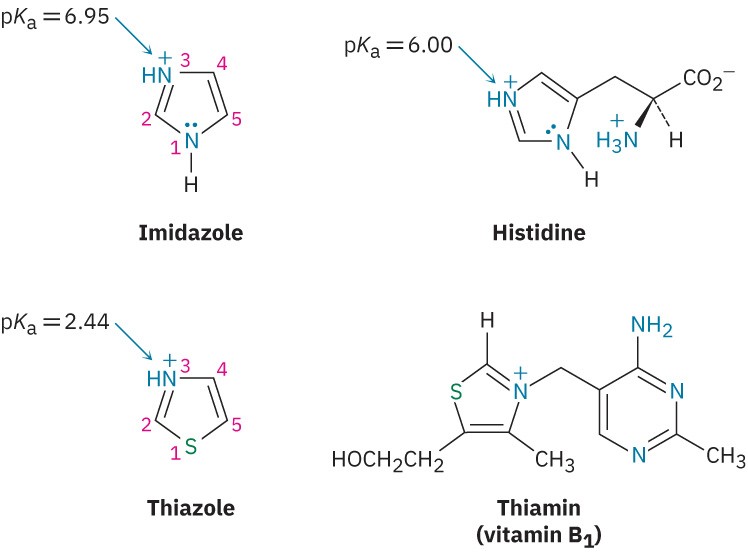
Problem 24-20
Draw an orbital picture of thiazole. Assume that both the nitrogen and sulfur atoms are sp2- hybridized, and show the orbitals that the lone pairs occupy.
Problem 24-21
What is the percent protonation of the imidazole nitrogen atom in histidine at a physiological pH of 7.3 (Section 24.5)?
Pyridine and Pyrimidine
Pyridine is the nitrogen-containing heterocyclic analog of benzene. Like benzene, pyridine is a flat, aromatic molecule, with bond angles of 120° and C–C bond lengths of 139 pm, intermediate between typical single and double bonds. The five carbon atoms and the sp2- hybridized nitrogen atom each contribute one π electron to the aromatic sextet, and the lone-pair electrons occupy an sp2 orbital in the plane of the ring (Section 15.5).
As shown previously in Table 24.1, pyridine (pKa = 5.25) is a stronger base than pyrrole but a weaker base than the alkylamines. The diminished basicity of pyridine compared with that of alkylamines is due to the fact that the lone-pair electrons on the pyridine nitrogen are in an sp2 orbital, while those on an alkylamine nitrogen are in an sp3 orbital. Because s orbitals have their maximum electron density at the nucleus but p orbitals have a node at the nucleus, electrons in an orbital with more s character are held more closely to the positively charged nucleus and are less available for bonding. As a result, the sp2- hybridized nitrogen atom (33% s character) in pyridine is less basic than the sp3- hybridized nitrogen in an alkylamine (25% s character).

Unlike benzene, pyridine undergoes electrophilic aromatic substitution reactions with difficulty. Halogenation can be carried out under drastic conditions, but nitration occurs in very low yield, and Friedel–Crafts reactions are not successful. Reactions usually give the 3- substituted product.
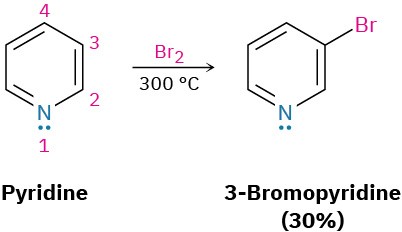
The low reactivity of pyridine toward electrophilic aromatic substitution is caused by a combination of factors. One is that acid–base complexation between the basic ring’s nitrogen atom and the incoming electrophile places a positive charge on the ring, thereby deactivating it. Equally important is that the electron density of the ring is decreased by the electron-withdrawing inductive effect of the electronegative nitrogen atom. Thus, pyridine has a substantial dipole moment (μ = 2.26 D), with the ring carbons acting as the positive
end of the dipole. Reaction of an electrophile with the positively polarized carbon atoms is therefore difficult.
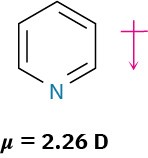
In addition to pyridine, the six-membered diamine pyrimidine is also found commonly in biological molecules, particularly as a constituent of nucleic acids. With a pKa of 1.3, pyrimidine is substantially less basic than pyridine because of the inductive effect of the second nitrogen.
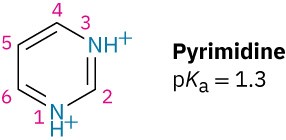
Problem 24-22
Electrophilic aromatic substitution reactions of pyridine normally occur at C3. Draw the carbocation intermediates resulting from reaction of an electrophile at C2, C3, and C4, and explain the observed result.
Polycyclic Heterocycles
As we saw in Section 15.6, quinoline, isoquinoline, indole, and purine are common polycyclic heterocycles. The first three contain both a benzene ring and a heterocyclic aromatic ring, while purine contains two heterocyclic rings joined together. All four ring systems occur commonly in nature, and many compounds with these rings have pronounced physiological activity. The quinoline alkaloid quinine, for instance, is widely used as an antimalarial drug; tryptophan is a common amino acid; and the purine adenine is a constituent of nucleic acids.
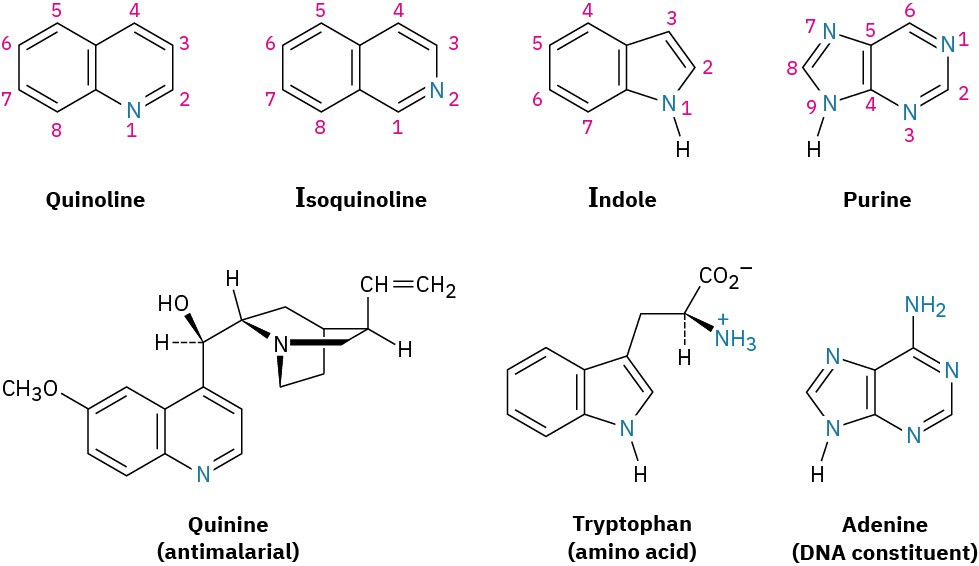
The chemistry of these polycyclic heterocycles is just what you might expect from a knowledge of the simpler heterocycles pyridine and pyrrole. Quinoline and isoquinoline both have basic, pyridine-like nitrogen atoms, and both undergo electrophilic substitutions. As with pyridine, both quinoline and isoquinoline are less reactive toward electrophilic substitution than benzene because of the electronegative nitrogen atom that withdraws electrons from the ring. Reaction occurs on the benzene ring rather than on the nitrogen- containing pyridine ring, and a mixture of substitution products is obtained.
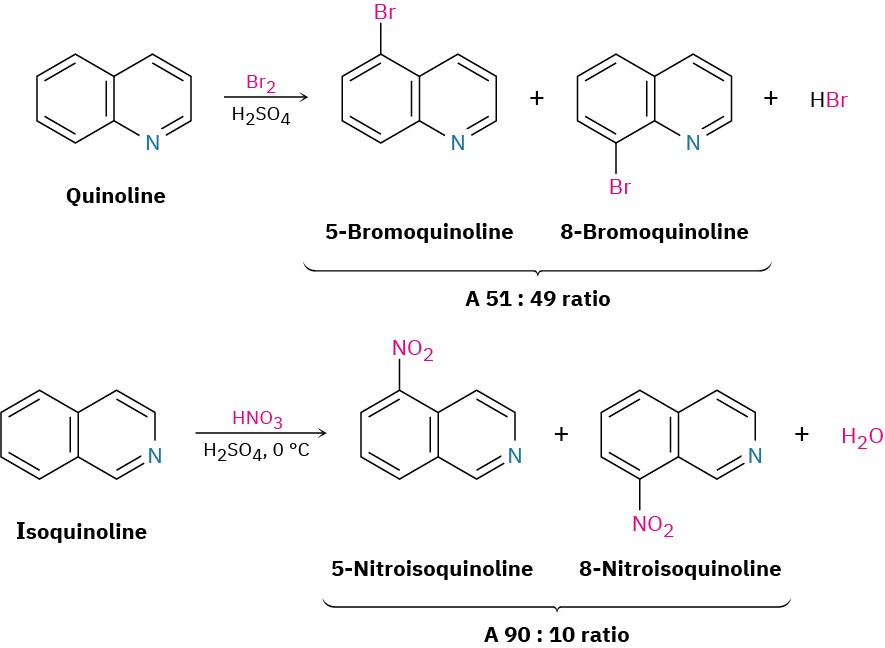
Indole has a nonbasic, pyrrole-like nitrogen and undergoes electrophilic substitution more easily than benzene. Substitution occurs at C3 of the electron-rich pyrrole ring rather than on the benzene ring.
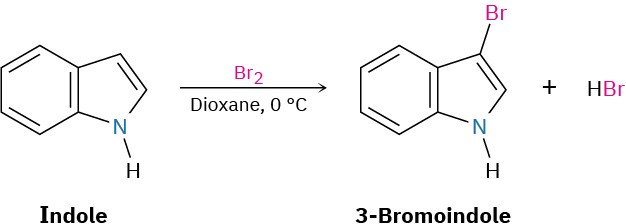
Purine has three basic, pyridine-like nitrogens with lone-pair electrons in sp2 orbitals in the plane of the ring. The remaining purine nitrogen is nonbasic and pyrrole-like, with its lone- pair electrons as part of the aromatic π electron system.
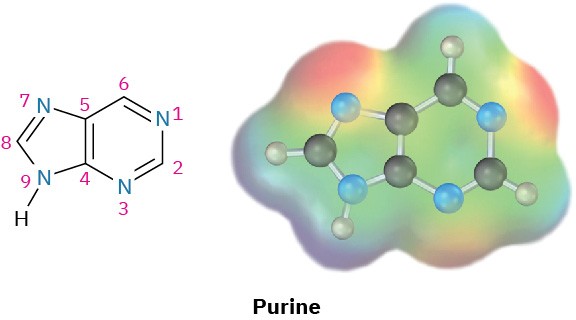
Problem 24-23
Which nitrogen atom in the hallucinogenic indole alkaloid N,N-dimethyltryptamine is more basic? Explain.
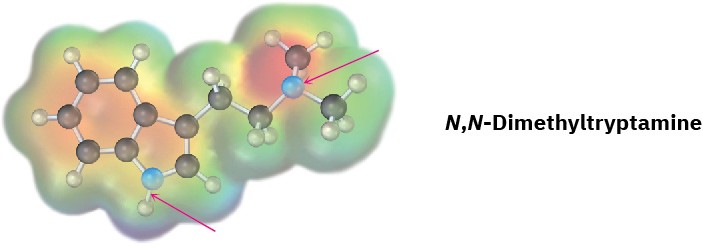
Problem 24-24
Indole reacts with electrophiles at C3 rather than at C2. Draw resonance forms of the intermediate cations resulting from reaction at C2 and C3, and explain the observed results.

